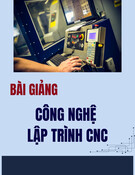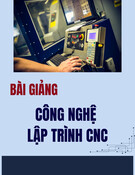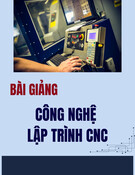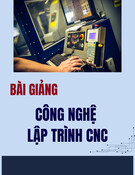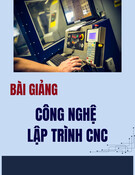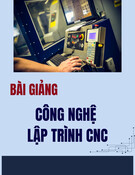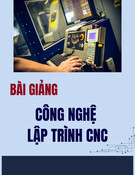Journal of Materials Processing Technology 191 (2007) 141–144
Examination of machining parameters on surface roughness in EDM of tool steel M. Kiyak a,∗, O. C¸ akır b a Department of Mechanical Engineering, Yildiz Technical University, 34349 Istanbul, Turkey b Department of Mechanical Engineering, Dicle University, 21280 Diyarbakir, Turkey
Abstract
Electrical discharge machining (EDM) is one of the important non-traditional machining processes and it is widely accepted as a standard machining process in the manufacture of forming tools to produce molds and dies. Since its introduction to manufacturing industry in late 1940s, EDM became a well-known machining method. The method is based on removing material from a workpiece by means of a series of repeated electrical discharges, produced by electric pulse generators at short intervals, between an electrode (tool) and a part being machined in dielectric fluid medium. This paper is devoted to a study of the influences of EDM parameters on surface roughness for machining of 40CrMnNiMo864 tool steel (AISI P20) which is widely used in the production of plastic mold and die. The selected EDM parameters were pulsed current (8, 16 and 24 A), pulse time (2, 3, 4, 6, 12, 24, 48 and 100 (cid:2)s) and pulse pause time (2 and 3 (cid:2)s). It was observed that surface roughness of workpiece and electrode were influenced by pulsed current and pulse time, higher values of these parameters increased surface roughness. Lower current, lower pulse time and relatively higher pulse pause time produced a better surface finish. © 2007 Elsevier B.V. All rights reserved.
Keywords: EDM; Tool steel; Current; Surface roughness
1. Introduction
medium. The electrical discharges generate impulsive pressure by dielectric explosion to remove the melted material. Thus, the amount of removed material can be effectively controlled to pro- duce complex and precise machine components. However, the melted material is flushed away incompletely and the remain- ing material resolidifies to form discharge craters. As a result, machined surface has microcracks and pores caused by high temperature gradient which reduces surface finish quality.
Electric discharge machining (EDM) is one of the most pop- ular non-traditional material removal processes and has became a basic machining method for the manufacturing industries of aerospace, automotive, nuclear, medical and die-mold produc- tion. The theory of the process was established by two Soviet scientists B.R. and N.I. Lazarenko in the middle of 1940s. They invented the relaxation circuit and a simple servo controller tool that helped to maintain the gap width between the tool and the workpiece. This reduced arcing and made EDM machining more profitable and produced first EDM machine in 1950s. Major development of EDM was observed when computer numerical control systems were applied for the machine tool industry. Thus, the EDM process became automatic and unattended machining method [1].
The process uses thermal energy to generate heat that melts and vaporizes the workpiece by ionization within the dielectric
There have been many published studies considering surface finish of machined materials by EDM. It was noticed that var- ious machining parameters influenced surface roughness and setting possible combination of these parameters was difficult to produce optimum surface quality. The influences of some machining parameters such as pulsed current [2–9], pulse time [2–6,8,9], pulse pause time [2,5,9], voltage [4,6], dielectric liq- uid pressure [4,6,8,10] and electrode material [11] have been examined. One study examined P20 tool steel and provided use- ful information the effects of some machining parameters on surface roughness, but the selected of pulsed current values was very low 1–8 A [12].
∗ Corresponding author.
E-mail addresses: kiyak@yildiz.edu.tr (M. Kiyak), ocakir@dicle.edu.tr
The present study examines the effects of pulsed current, pulse time and pulse pause time on surface roughness in the 40CrMnNiMo864 tool steel (AISI P20) tool steel.
(O. C¸ akır).
0924-0136/$ – see front matter © 2007 Elsevier B.V. All rights reserved. doi:10.1016/j.jmatprotec.2007.03.008
M. Kiyak, O. C¸ akır / Journal of Materials Processing Technology 191 (2007) 141–144 142
Table 1 Properties of workpiece material
Chemical composition (%)
C Cr Mn Mo S Si Ni
0.37 2 1.4 0.2 Max. 0.01 0.3 1
290–341 HB 205 GPa 29 W/m K Hardness Elasticity module (E) Thermal conductivity
2. Experimental procedures
Fig. 1. Effects of pulse time and pulsed current on surface roughness of work- piece (2 (cid:2)s pulse pause time).
3. Experimental results and discussion
First part of the experimental study carried out for machined
workpiece surface finish quality.
The experimental study was carried out on AJAN EDM 982 machine. The dielectric liquid was a brand of Cuttex Fel Ultra. The viscosity of dielec- tric fluid was 2.2–2.7 at 40 ◦C and the lightning point was 105 ◦C/min. The selected workpiece material was 40CrMnNiMo864 (AISI P20) that was widely used in die and mold manufacturing industry. The properties of workpiece material were presented in Table 1. The workpiece specimen was prepared 20 mm × 70 mm × 315 mm of dimension and the surfaces of workpiece were milled and finish ground before EDM method application. The possible more influential machining parameters were selected according to literature review. The list of selected machining parameter values was given in Table 2.
Fig. 1 gives the experimental result of surface roughness when 2 (cid:2)s pulse pause time was used with different pulsed current and pulse times. It was observed that surface roughness increased when higher pulse time was used. Similar result was noticed for pulse current values, higher currents produced poor surface finish.
A cylindrical pure copper with a diameter of 22 mm was used as an electrode which was finish ground before experimental study. It was mounted axially in line with workpiece.
The surface roughness of the machined surface was measured by using Taylor Hobson Surtonic 3+ surface test equipment. The surface roughness, which is measured by central line average (Ra) was employed to asses the quality of the machine surface quantitatively. Each surface roughness value was obtained by averaging five measurements at various positions of workpiece and electrode surfaces for each machining condition. The surface measurement filter of this equipment was 2CR type. The cut-off length was set as 2.5 mm. The evaluation length was selected as the maximum value which was 2.5 mm. Stylus type was diamond with 5 (cid:2)m radius.
When pulse pause time increased from 2 to 3 (cid:2)s, similar results were obtained (Fig. 2). Higher pulse time and pulsed current produced poor surface finish. However, up to certain pulse time (6 (cid:2)s), surface roughness was different comparing to 2 (cid:2)s pulse pause time results. For the same machining condi- tions, surface roughness was 2–3 (cid:2)m for 2 (cid:2)s pulse pause time and 6 (cid:2)m for 3 (cid:2)s pulse pause time. Pulsed current showed a similar trend, increasing current gave high surface roughness.
Table 2 Parameters of examinations
Number of test
1 2 3 4 5 6 7 8 9 10 11 12 13
8 2 2 1.8 1.8 8 4 2 3.8 2.2 8 6 2 5.3 2.6 8 12 2 5.7 3.0 8 24 2 7.2 3.1 8 48 2 8.1 3.3 8 100 2 8.7 3.4 8 3 3 1.8 2.1 8 4 3 2.4 2.6 8 12 3 5.0 3.0 8 24 3 6.3 3.1 8 48 3 8.0 3.2 8 100 3 8.9 3.3 Pulsed current (A) Pulse time ((cid:2)s) Pulse pause time ((cid:2)s) Surface roughness (Ra) (workpiece) Surface roughness (Ra) (electrode)
Number of test
1 2 3 4 5 6 7 8 9 10 11 12 13
16 2 2 2.5 2.2 16 4 2 5.0 3.4 16 6 2 6.4 3.6 16 12 2 6.7 3.7 16 24 2 8.4 4.3 16 48 2 9.3 4.6 16 10 2 10.4 4.7 16 3 3 2.3 2.5 16 4 3 3.0 3.0 16 12 3 5.7 3.8 16 24 3 7.0 3.9 16 48 3 8.6 4.3 16 100 3 10.1 4.3 Pulsed current (A) Pulse time ((cid:2)s) Pulse pause time ((cid:2)s) Surface roughness (Ra) (workpiece) Surface roughness (Ra) (electrode)
Number of test
1 2 3 4 5 6 7 8 9 10 11 12 13
16 2 2 3.1 3.0 16 4 2 5.2 3.5 24 6 2 6.7 3.6 24 12 2 8.5 3.9 24 24 2 9.4 4.4 24 48 2 9.7 4.7 24 100 3 11.3 4.8 24 3 3 3.0 3.0 24 4 3 3.2 3.1 24 12 3 6.6 3.8 24 24 3 7.5 4.2 24 48 3 9.0 4.4 24 100 3 10.9 4.4 Pulsed current (A) Pulse time ((cid:2)s) Pulse pause time ((cid:2)s) Surface roughness (Ra) (workpiece) Surface roughness (Ra) (electrode)
M. Kiyak, O. C¸ akır / Journal of Materials Processing Technology 191 (2007) 141–144 143
Fig. 2. Effects of pulse time and pulsed current on surface roughness of work- piece (3 (cid:2)s pulse pause time). Fig. 4. Effects of pulse time and pulsed current on surface roughness of electrode (3 (cid:2)s pulse pause time).
vided better surface quality comparing to 3 (cid:2)s of pulse pause time.
Surface finish quality was better when applying smaller pulsed current and pulse time. This is because of small parti- cle size and crater depths formed by electrical discharge. As a result, the best surface finish will be produced. The selection of these machining parameters for EDM of any material should be used for a higher surface quality is required.
Similar surface roughness results were noticed for electrode surface roughness. It was observed that the surface roughness of electrode was better when applying smaller pulsed current and pulse time. When pulsed current and pulse time increased, electrode surface presented a higher surface roughness. Pulsed current had an effect on surface roughness of electrode at low pulse time, but the influence of pulse time was more significant than pulsed current at higher pulse times. The effect of pulse pause time was insignificant.
It was observed that when pulsed current and particularly pulse time increased, machined workpiece surface exhibited a higher surface roughness due to irregular topography. Pulsed current had an effect on surface roughness at low pulse time, but the influence of pulse time was more significant than pulsed current at higher pulse times.
4. Conclusion
The experimental study of the EDM of 40CrMnNiMo864 tool steel (AISI P20) tool steel provided important quantitative results for obtaining possible high surface finish quality and machining outputs as follows:
It was noticed that excellent machined surface quality could be obtained by setting machining parameters at a low pulse cur- rent and short pulse time. This combination will unfortunately produce low material removal rate and cause high machining time, in total high machining cost. When high material removal rates are needed, high pulsed current and pulse times should be selected. However, this selection will produce a poor sur- face finish due to deeper and wider crates on the machined surface. There is also an influence on dielectric fluid at high pulsed current; the properties will be lost because of high temperature.
a. Surface roughness increased with increasing pulsed current and pulse time. Low current and pulse time with high pulse pause time produced minimum surface roughness that means good surface finish quality. The selection of these machining parameters is not useful because machining process gener- ally becomes very slow. Material removal rate will be low and thus machining cost increases. This combination should be used in finish machining step of EDM process.
Second stage of the experimental study considered to exam- ine the surface roughness of electrode. The bottom surface of the electrode, which is continuously contacted to work- piece, was investigated. For the same machining conditions, the experimental results were given in Figs. 3 and 4. Low pulse times and pulsed currents provided a better surface qual- ity for both duration times. It was observed that pulse pause time was an influential parameter; 2 (cid:2)s of pulse pause time pro-
b. High pulsed current and pulse time provide low surface finish quality. However, this combination would increase material removal rate and reduce machining cost. As a result, this combination (high pulsed current and pulse time) should be used for rough machining step of EDM process.
c. From power point of view, rough and finish machining steps require different level of machine power. For rough EDM application, the machine power should be one-fourth of the produced power with 16 A of current, 6 (cid:2)s of pulse time and 3 (cid:2)s of pulse pause time. Finish machining should be carried out at one-half level of power at 8 A of current as well as 6 (cid:2)s of pulse time and 3 (cid:2)s of pulse pause time.
d. Increasing wear on electrode surface is unavoidable during EDM process. Therefore, workpiece surface roughness will be increasing due to wear rate on electrode.
Fig. 3. Effects of pulse time and pulsed current on surface roughness of electrode (2 (cid:2)s pulse pause time).
e. Wear on electrode surface is unavoidable during EDM process. Surface roughness of machined workpiece would
M. Kiyak, O. C¸ akır / Journal of Materials Processing Technology 191 (2007) 141–144 144
increase when surface quality of electrode decreases due to pulsed current density.
[4] S.H. Lee, X.P. Li, Study of the effect of machining parameters on the machining characteristics in electrical discharge machining of tungsten carbide, J. Mater. Process. Technol. 115 (2001) 344–358.
[5] H.S. Halkacı, A. Erden, Experimental investigation of surface roughness in electric discharge machining (EDM), in: Proceedings of the 6th Biennial Conference (ESDA 2002), Istanbul, Turkey, 2002, pp. 1–6.
f. For the same pulse pause time, the trends of surface rough- ness on the workpiece and electrode are similar. Thus, there will be a relation between wear on electrode and increase of surface roughness from workpiece surface quality point of view.
[6] S.H. Lee, X. Li, Study of the surface integrity of the machined workpiece in the EDM of tungsten carbide, J. Mater. Process. Technol. 139 (2003) 315–321.
Acknowledgements
[7] Y.H. Guu, H. Hocheng, C.Y. Chou, C.S. Deng, Effect of electrical discharge machining on surface characteristics and machining damage of AISI D2 tool steel, Mater. Sci. Eng. A 358 (2003) 37–43.
[8] C. C¸ o˘gun, B. Kocabas¸, A. ¨Ozgedik, Experimental and theoretical investi- gation of workpiece surface roughness profile in EDM, J. Fac. Eng. Arch. 19 (2004) 97–106 (in Turkish).
Authors would like to thank two companies (OPAS and ERDEM) for kind encouragement and technical support. They are also thankful to Mech. Eng. C¸ a˘gatay ACAR for his sincere help throughout this research.
[9] Y. Keskin, H.S. Halkacı, M. Kızıl, An experimental study for determi- nation of the effects of machining parameters on surface roughness in electrical discharge machining (EDM), Int. J. Adv. Manuf. Tech. 28 (2006) 1118–1121.
References
[1] K.H. Ho, S.T. Newman, State of the art electrical discharge machining (EDM), Int. J. Mach. Tools Manuf. 43 (2003) 1287–1300. [2] P.V. Ramarao, M.A. Faruqi, Characteristics of the surfaces obtained in [10] A. ¨Ozgedik, C. C¸ o˘gun, An experimental investigation of tool wear in electric discharge machining, Int. J. Adv. Manuf. Tech. 27 (2006) 488–500. [11] S. Singh, S. Maheshwari, P.C. Pandey, Some investigations into the elec- tric discharge machining of hardened tool steel using different electrode materials, J. Mater. Process. Technol. 149 (2004) 272–277. electro-discharge machining, Prec. Eng. 4 (1982) 111–113.
[12] F.L. Amorim, W.L. Weingaertner, The influence of generator actuation mode and process parameters on the performance of finish EDM of a tool steel, J. Mater. Process. Technol. 166 (2005) 411–416. [3] C.C. Wang, B.H. Yan, H.M. Chow, Y. Suzuki, Cutting austempered duc- tile iron using an EDM sinker, J. Mater. Process. Technol. 88 (1999) 83–89.


![Gậy Dẫn Đường Thông Minh Cho Người Khiếm Thị: [Ưu điểm/Tính năng/Kinh nghiệm chọn mua]](https://cdn.tailieu.vn/images/document/thumbnail/2025/20250422/gaupanda088/135x160/6991745286495.jpg)


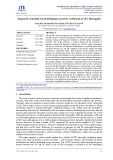
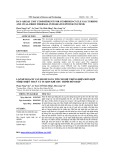
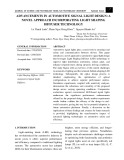
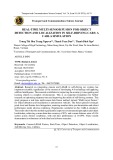
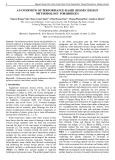
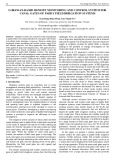
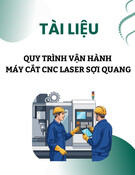

![Bài tập tối ưu trong gia công cắt gọt [kèm lời giải chi tiết]](https://cdn.tailieu.vn/images/document/thumbnail/2025/20251129/dinhd8055/135x160/26351764558606.jpg)




